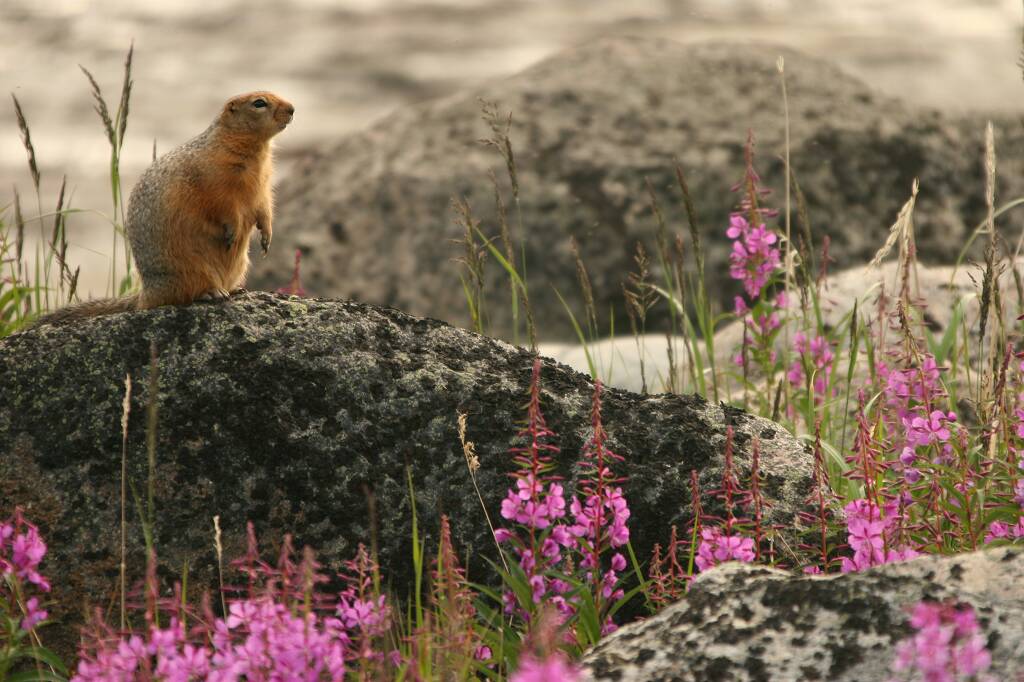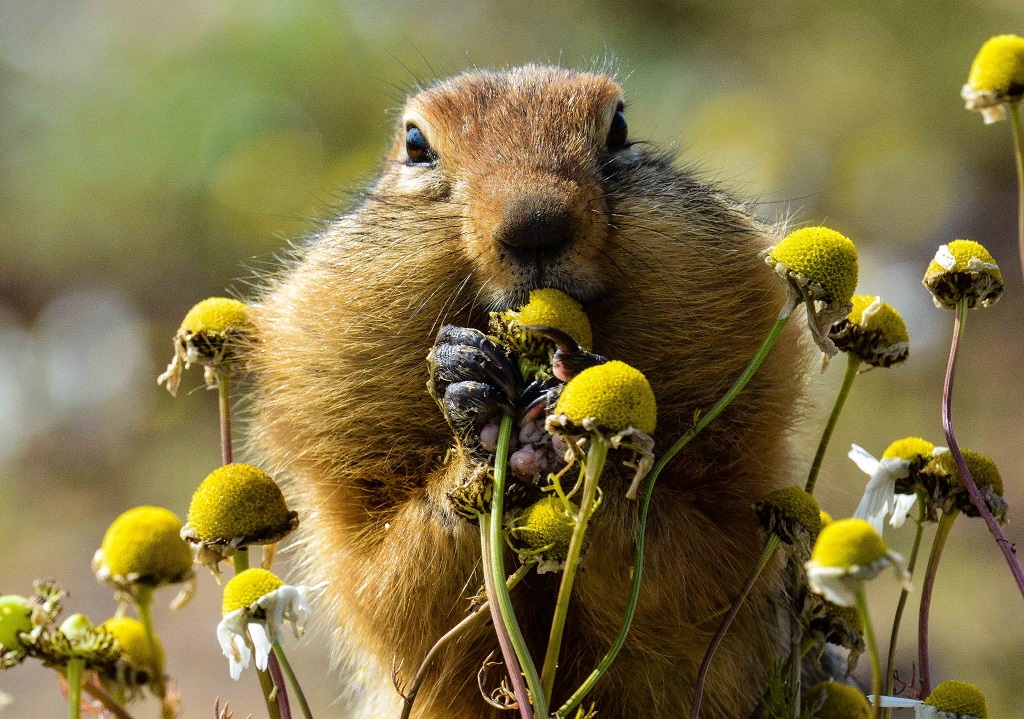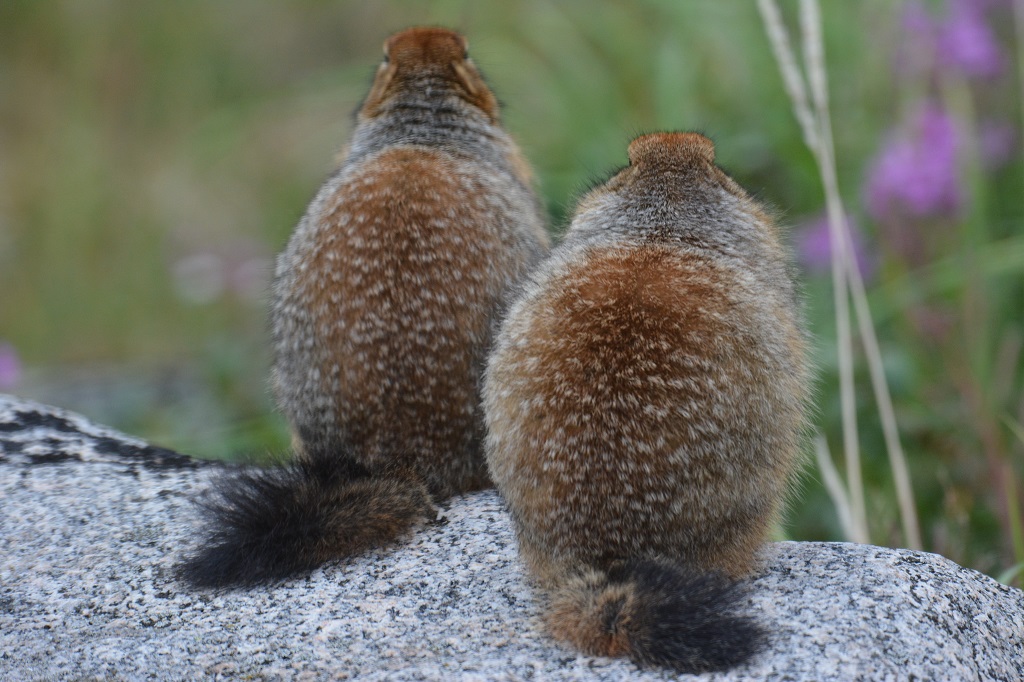Humans have always been drawn to animals’ impressive power, movement, colour and size. Cheetahs are revered for their speed and unique spots; polar bears for being one of the largest carnivores on the planet; birds-of-paradise for their rainbow of feathers. With so much power and beauty on display in the animal kingdom, it’s sometimes easy to overlook the smaller creatures.
With its clever design, the Arctic ground squirrel — or, as the Inuit call them, “sik-sik,” possibly due to the “tsik-tsik” sounds they make during their constant chatter — is not to be outdone by a polar bear or beluga whale. Sik-siks are undeniably adorable and have charmed many a guest over the years at our polar bear lodges. In the late summer sik-siks grow quite chunky in preparation for winter and can often be heard yelling at each other over the sea lyme grass or warning each other about an approaching predator.
Sik-siks are hearty creatures, and they are helping aid in ground-breaking research. Scientific American wrote an article about Sik-siks in 2012 entitled “What the Supercool Arctic Ground Squirrel Teaches Us about the Brain’s Resilience.” We’ll explain what they discovered later, but you need to know that these squirrely little bad-asses know how to beat winter better than almost any other animal.
Arctic ground squirrels spend the summer gathering moss, sea lyme grass and caribou hair for nests while also foraging for berries, mushrooms and other plants to shore up their stores of fat. (The reverse of what humans strive for every summer before going to the beach!) Sik-siks need the fat to survive underground through the long cold Arctic winters, which can begin as early as September and last 9-10 months.
Their body temperature plummets below freshwater freezing temperatures. Their core temperature stays approximately minus 2.9°C, while their neck and head remain at about 0.7°C. Can you imagine being able to regulate your body temperature by zone?
While in hibernation, a sik-sik’s blood remains liquid, another fascinating feature of these creatures attributed to the phenomenon of supercooling. Their hearts slow to about three beats per minute when peak popsicle form is achieved, and every two to three weeks, they will shiver themselves awake. It’s believed that the sheer effort of moving the blood starts to create heat in the body. Once awake, sik-siks maintain a regular body temperature for 12-15 hours while they eat from their pantry. After that, it’s back to sleep!
And scientists have discovered that it’s not just sustenance that these little marvels wake up for. What makes them so special is their brain’s ability to shrink neurons during hibernation. Some connections shrivel completely, yet their brain recovers, thanks to their intermittent wake-up calls. Without the periodic wake-ups, their brains would be destroyed long before spring.
Arctic ground squirrels also undergo periodic growth spurts in the brain to counteract hibernation damage, developing even more neural links than before their frozen sleep.
Why is this so fascinating? Well, it has many implications for understanding neurodegenerative diseases and the capabilities of the brain, the most complex organ in all species. One of the main diseases it could have implications for is Alzheimer’s. It’s estimated that these little furry ground squirrels, along with others of their kind, use about 80-90 percent of their energy to keep their brains alive during the winter months (Jabr, 2012).
It seems that sik-siks know how to push the boundaries of science. They were once again the topic of research in 2016, this time in relation to heart and stroke patients.
In an article posted by Anchorage Daily News, scientists discovered a key to the Arctic ground squirrels’ metabolic capabilities in the form of an enzyme that allows the squirrels to switch from burning carbohydrates to burning fat. It’s called sirtuin-3, and they say it “can help regulate metabolism, fight stress and ward off the effects of aging.” Sound too good to be true? It’s also related to the enzyme found in red wine.
How might this information help a victim of a heart attack, hypothermia, or stroke? When a human’s heart stops or nearly stops, there is severe damage to the body, but this isn’t the case for squirrels. Scientists are looking into when and how the switch is made to start burning the fat instead of the tissue (Rosen, 2016).
After all this exhausting freezing and thawing, what happens to sik-siks in the spring? The males wake up first, which BBC attributes to a circannual clock in their brains and being able to feel the change in ground temperature. They’ve lost quite a bit of weight at this point, and they start to finish off the food they stored up before hibernation. (Gough, 2015).
When the females wake up a few weeks later, they start procreating. With only three months until the next winter, they have to be quick about storing food and making babies. Mating rituals include a lot of male-male competition for mating rights, and most litters ranging from 5-10 pups will have multiple sires. The gestation period is around 25 days, and pups are born hairless, weighing around 0.35 ounces — approximately the weight of five seedless grapes (Hopkins, unknown).
Typically, sik-siks eat berries, flowers, seeds and various plants. I have personally witnessed one particularly feral-looking squirrel consuming a baby bird. They will also eat the remains of each other. They have to be opportunistic to raise their fat stores quickly. At Seal River Heritage Lodge, birds of prey such as eagles and gyrfalcons, as well as any type of fox, are their main predators, but sik-siks that are quick enough can live to be nine years old.
Surprisingly, sik-siks undergo a coat change with the seasons, despite not needing to be able to blend into the snow. It’s subtle enough that in the face of an Arctic fox, which also changes its coat from dark brown to snow white, you may not even notice it. A sik-sik’s facial and side markings will change from red and yellow colourations to silver, helping it blend in with the dying grasses and plants in early fall.
And there you have it! Making special appearances during our Birds, Bears and Belugas tours, the most underrated animal at Seal River Heritage Lodge: the Arctic ground squirrel. Because the nearby Seal River marks the southernmost point in the sik-siks’ geographical range, these fascinating little squirrels are truly unique to the area. They’re also chubby and cute and love to pose for photos!
Start planning your next adventure today!
Written by Allison Francoeur
Works Cited
Gough, Z. (2015, February 18). Arctic Ground Squirrels’ Supercool Slumber. Retrieved from BBC: http://www.bbc.com/earth/story/20150218-arctic-ground-squirrels-supercool-slumber
Hopkins, B. (unknown). Arctic Ground Squirrel. Retrieved from Blue Planet Biomes: http://www.blueplanetbiomes.org/arctic_ground_squirrel.htm
Jabr, F. (2012, June 26). What the Supercool Arctic Ground Squirrel Teaches Us about the Brain’s Resilience. Retrieved from Scientific American: https://www.scientificamerican.com/article/arctic-ground-squirrel-brain/
Rosen, Y. (2016, June 26). Scientists have unlocked one secret to Arctic ground squirrels’ deep-freeze – and that could be a big deal for humans. Retrieved from Anchorage Daily News: https://www.adn.com/arctic/2016/06/26/arctic-ground-squirrels-deep-freeze-hibernation-gives-clues-to-better-survival-for-human-cardiac-patients/











